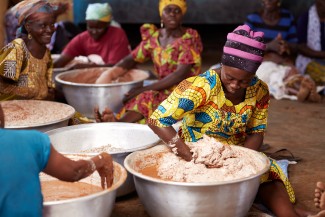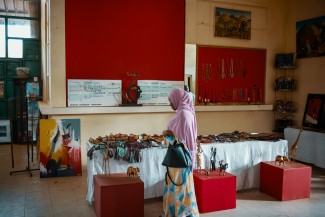|
|
|
In the winter of 2016, I met an oil tycoon from Nigeria in a Riyadh Airport arrival lounge who continued to lament the deviousness of commodity cycles, then abruptly announced that “logistics” was the new black gold.
He intended to fund a business that would rent cargo allowances from regular airline passengers for much less, he had calculated, than the equivalent container units in a conventional air cargo freighter. He wanted to know whether medicines could be carried through this channel legally.
It is a more intriguing question than it looks at first. Medicines offer one of the most spectacular value-to-volume ratios. This has long allowed usually expensive air cargo options to become commonplace in Africa’s medical trade, where small consignments made up of a few tens of thousands of product packs, shipped at irregular intervals in a very agile mode of commerce, typically make perfect business sense on the vast majority of routes.
For many high-end medical brands, a suitcase is all one requires to bring in close to a million dollars of valuable merchandise. The same of course cannot be said of cooking oil or clothing. Even high-end phones, another item that cooperates very well with this mode of commerce, do not measure up to chronic medicines on this criterion of “weight-to-value” ratio.
Obviously, “good distribution practices” and the highly regulated nature of the trade means that agile logistics of this extreme “suitcase carriage” type often tend to occur only in the informal segment of the trade, a segment saturated with dodgy dealings, from counterfeiting to grey marketing.
A fragmented medicine retail environment
The truth nevertheless remains that the medicine retail environment in Africa is presently dominated by highly fragmented structures. Nigeria, for instance, has more than 200,000 medicine retail points in the country (with barely 3% registered). Ghana has nearly 10,000 licensed outlets. Virtually all of these shops are standalone facilities.
My calculations indicate that in no Anglophone West African country do integrated supply chains account for more than 5% of distribution. Attempts to build outlet chains like in Europe and North America have been halting and inconsistent for the most part, sometimes leading to bad blood between investors and entrepreneurs, and frequent allegations of governance deficits.
In such an environment, agile logistics on the back end and ecommerce on the front end would be a compelling choice for entrepreneurs seeking to create an optimisation strategy from the chaotic raw material they have been dealt.
Savvy entrepreneurs are indeed trying to weave such trading strategies together. My analysis of 20 such e-pharmacy ventures across Africa shows that those who succeed in raising capital and maintaining even a modicum of growth do so primarily on the back of the brick-and-mortar components of their setup, with the pure online part of their operations contributing less than 5% of value.
A major impact of fragmentation is on pricing. A 2018 analysis by the Gates Foundation of the value chain of a birth control pill (Levonorgestrel) found that: “Markups along the chain vary widely, but can result in retail prices that are 10X the 1st line buyers cost and 50X the ex-manufacturers cost. There is no end-to-end visibility on the product movement.”
The African Medical Supply Platform
It was unto this stage that COVID-19 made its grand entry into Africa in February of this year. In a global environment convulsed by supply chain disruptions across every line of trade, shortages of personal protective equipment, medicines, test kits and reagents prompted a range of policy responses. A study by Pamela Steele Associates reported 75% of respondents as testifying to significant or highly significant increases in counterfeit medicines and medical products partly due to severe export restrictions imposed in China and India.
One of the more elaborate responses centred on the potential role of intergovernmental coordination and the use of Africa’s burgeoning continental free trade zone to create a humanitarian logistics corridor. Some creative partnerships later, the Africa Medical Supply Platform (AMSP) was born.
Intriguingly however the AMSP’s strategy for addressing the competing pressures of “quality regulation” and “supply chain optimisation” has been to opt for a closed system accessible to only pre-vetted buyers, initially large public sector procurers, whilst riding on intergovernmental mechanisms to drive a “pooled procurement” model.
The “pooling” function of the AMSP has yet to fully gel since procurement decisions remain primarily national and generally bureaucratic, prompting an experiment to increase health system touchpoints.
Optimising African pharma supply chains
This leads us to the core of the matter: the tension between agility and scale in optimising African pharma supply chains to increase both access (as a function of supplier cost reduction and affordability to the end consumer) and quality assurance (as a function of superior regulatory visibility, control and auditability). Is agile openness and supply chain integrity compatible? Is this tension an irresolvable dilemma or a mere dialectic awaiting synthesis?
A synthesis is indeed possible. An open network of supply chain actors glued by tools that improve accountability and visibility is absolutely feasible technically. Organisations and initiatives like GS1, Agrotrack [disclaimer: the author is affiliated], and various OpenLMIS efforts can all point to working models of success in various bright spots on the African continent.
Invariably, such success boils down to “localised innovations” within “adaptable traceability” systems that do not penalise small and highly agile traders, retailers, manufacturers and distributors, and thus retain hope of addressing various last mile and frontier barriers preventing good medicine from reaching the poor, especially in rural areas.
The problem is that these sparkling gems rarely attain sufficient mainstream credibility. The Nigerian Government’s NAFDAC Mobile Authentication Service (MAS) programme, using a combination of cutting-edge cloud-computing technologies and low-end GSM tools, for instance, enabled end-to-end visibility of distribution in anti-malarial medicines almost a decade before similar initiatives in Europe and the US fully took hold. This was done with no perceptible increase in supply chain constraints or cost to key actors. Yet, attempts to scale the concept across Africa have contended with a balkanised regional regulatory framework.
The emergence of new cooperative forces
Formal multilateral structures for connecting small and agile independent supply chain actors and deploying clever, low-cost, tools to track and trace product movements in the “supply webs” thus created do not appear feasible from the evidence. But there is an alternative: the use of cooperative mechanisms that crisscross borders and acquire scale, thereby attaining enough political weight to compel formal state systems to adjust and accommodate.
The Africa Christian Health Associations Platform (ACHAP) is a very notable candidate for the emergence of such a force. In the frightening, heady days of the COVID-19 pandemic, ACHAP partnered with IMA World Health to quietly build a multi-country web of interventions that leveraged the distributed scale of the platform.
What is even more fascinating about the “Christian health associations” in various countries (a feature shared in part by some other faith-based networks in the region) is their ability to embed within state health structures whilst retaining considerable operational autonomy. Added to their regional footprint, this political agility is a key building block for scale economics across novel and emerging supply chain transformation opportunities trans-continentally.
As this calm but gathering force starts to build momentum, increasingly evident in HIV supply chain contexts and other domains, system thinkers need to start paying much more attention than they have done to date.
- - - - -
Bright Simons is a systems entrepreneur and think tank executive. He is the President of mPedigree and a 2019 Skoll Awardee.
Header image of women sifting coffee beans for export in Addis Ababa - ©Pete Lewis/UK Department for International Development via Flickr Creative Commons Attribution 2.0 Generic (CC BY 2.0) license.
If you would like to reuse any material published here, please let us know by sending an email to EIF Communications: eifcommunications@wto.org.


